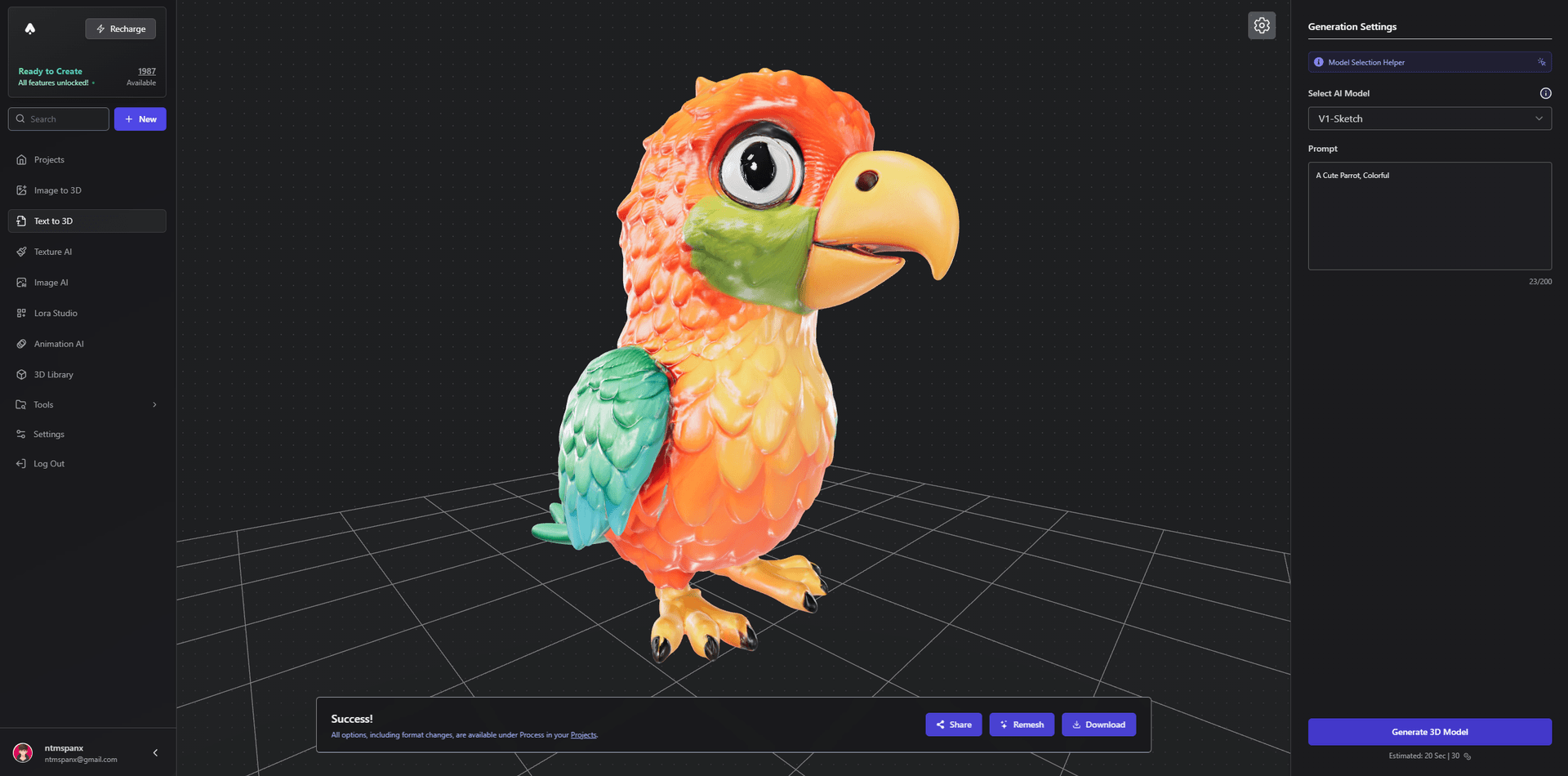Getting 3D Models for AR/VR: The Complete Guide (Save Time & Money)
Creating immersive AR and VR experiences requires high-quality 3D models, but traditional methods can be expensive and time-consuming. Whether you're developing a VR game or an AR application, getting the right 3D models is crucial. Let's explore how to efficiently obtain and prepare 3D models for AR/VR while saving time and money.
Traditional Methods vs Modern Solutions
Traditional 3D modeling for AR/VR typically involves:
- Manual modeling: 20-40 hours per detailed model
- Hiring 3D artists: $50-150 per hour
- Asset store purchases: $20-100 per model
- Outsourcing: $200-1000 per model
Modern AI-powered solutions like 3D AI Studio can reduce this to:
- 5-15 minutes per model
- No specialized skills required
- Fraction of the traditional cost
- Instant iterations and variations

Key Requirements for AR/VR Models
Your 3D models need specific characteristics for optimal AR/VR performance:
Performance Requirements:
- Polygon count: 50k-100k for VR, 10k-50k for AR
- Texture resolution: 2K-4K for VR, 1K-2K for AR
- Real-world scale accuracy
- Proper UV mapping
- Optimized materials
Technical Specifications:
- Water-tight meshes
- Clean topology
- Proper LODs (Levels of Detail)
- PBR materials
- Collision geometry

Cost Analysis: Traditional vs AI-Powered
Let's break down the costs for a typical AR/VR project requiring 50 models:
Traditional Method:
- Freelance 3D artist: $5000-15000
- Asset store purchases: $1000-5000
- Revisions and iterations: Additional 20-40% cost
- Time: 2-3 months
Using AI-powered tools:
- 3D AI Studio subscription: Fraction of traditional cost
- Time: 1-2 weeks
- Unlimited iterations
- No additional revision costs
Optimizing Models for AR/VR
Once you have your models, they need proper optimization:

Performance Optimization:
- Reduce polygon count while maintaining detail
- Optimize texture sizes
- Create efficient UV layouts
- Generate proper LODs
- Implement occlusion culling
Material Setup:
- Use PBR materials
- Optimize texture maps
- Implement proper shading
- Consider platform limitations
Real-World Applications
AR Applications:
- Product visualization
- Educational content
- Interior design
- Architecture visualization
- Training simulations
VR Applications:
- Gaming environments
- Virtual showrooms
- Training scenarios
- Social VR spaces
- Entertainment experiences

Time-Saving Workflow
Efficient Model Creation:
- Generate base model using AI tools
- Quick optimization and cleanup
- Platform-specific export
- Implementation and testing
Traditional workflow: 2-5 days per model AI-powered workflow: 15-30 minutes per model
Platform-Specific Considerations
Meta Quest Requirements:
- Optimized polygon count
- Efficient textures
- Performance-focused materials
- Mobile-friendly shaders
Apple Vision Pro Specifications:
- High-resolution textures
- Detailed models allowed
- Advanced material support
- Real-world scale importance
PSVR2 Considerations:
- Console-specific optimizations
- High-quality textures possible
- Advanced shader support
- Performance budgets
Implementation Tips
For Successful AR:
- Consider real-world lighting
- Plan for various environments
- Design for user interaction
- Test in different conditions
For Effective VR:
- Focus on comfort and scale
- Optimize for performance
- Consider user perspective
- Plan for interaction mechanics
Cost-Effective Strategies
Asset Management:
- Create modular components
- Reuse and repurpose models
- Build asset libraries
- Implement variation systems
Resource Optimization:
- Use automated tools
- Batch process similar assets
- Implement efficient workflows
- Maximize resource reuse
Quality Assurance
Testing Procedures:
- Performance benchmarking
- Visual quality checks
- Platform compatibility
- User experience testing
Quality Metrics:
- Frame rate monitoring
- Draw call optimization
- Memory usage
- Loading times
Future-Proofing Your Pipeline
Scalable Workflow:
- Use standardized processes
- Implement version control
- Document procedures
- Plan for updates
Emerging Technologies:
- Stay updated with platform changes
- Adapt to new requirements
- Monitor industry trends
- Prepare for future platforms
Getting Started
Ready to transform your AR/VR development pipeline? Visit 3D AI Studio to see how AI-powered tools can revolutionize your workflow. Our platform offers:
- Instant 3D model generation
- Automatic optimization
- Platform-specific export options
- Significant time and cost savings
Don't let traditional 3D modeling bottleneck your AR/VR development. Join thousands of developers who have already streamlined their workflow with AI-powered solutions.
Start creating your AR/VR content more efficiently today at 3D AI Studio.